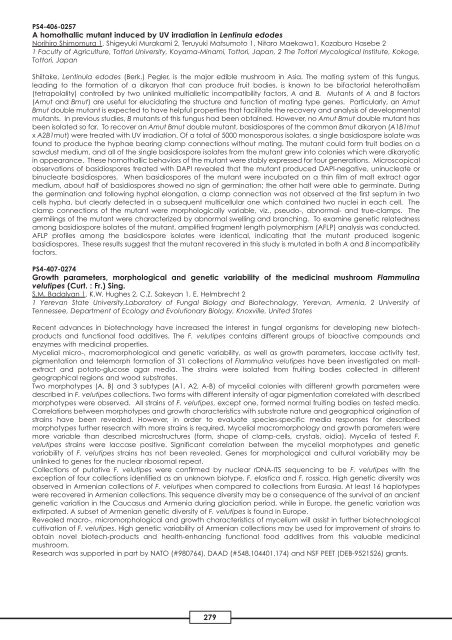Handbook Part 2 - International Mycological Association
Handbook Part 2 - International Mycological Association
Handbook Part 2 - International Mycological Association
Create successful ePaper yourself
Turn your PDF publications into a flip-book with our unique Google optimized e-Paper software.
PS4-406-0257<br />
A homothallic mutant induced by UV irradiation in Lentinula edodes<br />
Norihiro Shimomura 1, Shigeyuki Murakami 2, Teruyuki Matsumoto 1, Nitaro Maekawa1, Kozaburo Hasebe 2<br />
1 Faculty of Agriculture, Tottori University, Koyama-Minami, Tottori, Japan, 2 The Tottori <strong>Mycological</strong> Institute, Kokoge,<br />
Tottori, Japan<br />
Shiitake, Lentinula edodes (Berk.) Pegler, is the major edible mushroom in Asia. The mating system of this fungus,<br />
leading to the formation of a dikaryon that can produce fruit bodies, is known to be bifactorial heterothallism<br />
(tetrapolality) controlled by two unlinked multialletic incompatibility factors, A and B. Mutants of A and B factors<br />
(Amut and Bmut) are useful for elucidating the structure and function of mating type genes. <strong>Part</strong>icularly, an Amut<br />
Bmut double mutant is expected to have helpful properties that facilitate the recovery and analysis of developmental<br />
mutants. In previous studies, B mutants of this fungus had been obtained. However, no Amut Bmut double mutant has<br />
been isolated so far. To recover an Amut Bmut double mutant, basidiospores of the common Bmut dikaryon (A1B1mut<br />
x A2B1mut) were treated with UV irradiation. Of a total of 5000 monosporous isolates, a single basidiospore isolate was<br />
found to produce the hyphae bearing clamp connections without mating. The mutant could form fruit bodies on a<br />
sawdust medium, and all of the single basidiospore isolates from the mutant grew into colonies which were dikaryotic<br />
in appearance. These homothallic behaviors of the mutant were stably expressed for four generations. Microscopical<br />
observations of basidiospores treated with DAPI revealed that the mutant produced DAPI-negative, uninucleate or<br />
binucleate basidiospores. When basidiospores of the mutant were incubated on a thin film of malt extract agar<br />
medium, about half of basidiospores showed no sign of germination; the other half were able to germinate. During<br />
the germination and following hyphal elongation, a clamp connection was not observed at the first septum in two<br />
cells hypha, but clearly detected in a subsequent multicellular one which contained two nuclei in each cell. The<br />
clamp connections of the mutant were morphologically variable, viz., pseudo-, abnormal- and true-clamps. The<br />
germilings of the mutant were characterized by abnormal swelling and branching. To examine genetic relatedness<br />
among basidiospore isolates of the mutant, amplified fragment length polymorphism (AFLP) analysis was conducted.<br />
AFLP profiles among the basidiospore isolates were identical, indicating that the mutant produced isogenic<br />
basidiospores. These results suggest that the mutant recovered in this study is mutated in both A and B incompatibility<br />
factors.<br />
PS4-407-0274<br />
Growth parameters, morphological and genetic variability of the medicinal mushroom Flammulina<br />
velutipes (Curt. : Fr.) Sing.<br />
S.M. Badalyan 1, K.W. Hughes 2, C.Z. Sakeyan 1, E. Helmbrecht 2<br />
1 Yerevan State University,Laboratory of Fungal Biology and Biotechnology, Yerevan, Armenia, 2 University of<br />
Tennessee, Department of Ecology and Evolutionary Biology, Knoxville, United States<br />
Recent advances in biotechnology have increased the interest in fungal organisms for developing new biotechproducts<br />
and functional food additives. The F. velutipes contains different groups of bioactive compounds and<br />
enzymes with medicinal properties.<br />
Mycelial micro-, macromorphological and genetic variability, as well as growth parameters, laccase activity test,<br />
pigmentation and telemorph formation of 31 collections of Flammulina velutipes have been investigated on maltextract<br />
and potato-glucose agar media. The strains were isolated from fruiting bodies collected in different<br />
geographical regions and wood substrates.<br />
Two morphotypes (A, B) and 3 subtypes (A1, A2, A-B) of mycelial colonies with different growth parameters were<br />
described in F. velutipes collections. Two forms with different intensity of agar pigmentation correlated with described<br />
morphotypes were observed. All strains of F. velutipes, except one, formed normal fruiting bodies on tested media.<br />
Correlations between morphotypes and growth characteristics with substrate nature and geographical origination of<br />
strains have been revealed. However, in order to evaluate species-specific media responses for described<br />
morphotypes further research with more strains is required. Mycelial macromorphology and growth parameters were<br />
more variable than described microstructures (form, shape of clamp-cells, crystals, oidia). Mycelia of tested F.<br />
velutipes strains were laccase positive. Significant correlation between the mycelial morphotypes and genetic<br />
variability of F. velutipes strains has not been revealed. Genes for morphological and cultural variability may be<br />
unlinked to genes for the nuclear ribosomal repeat.<br />
Collections of putative F. velutipes were confirmed by nuclear rDNA-ITS sequencing to be F. velutipes with the<br />
exception of four collections identified as an unknown biotype, F. elastica and F. rossica. High genetic diversity was<br />
observed in Armenian collections of F. velutipes when compared to collections from Eurasia. At least 16 haplotypes<br />
were recovered in Armenian collections. This sequence diversity may be a consequence of the survival of an ancient<br />
genetic variation in the Caucasus and Armenia during glaciation period, while in Europe, the genetic variation was<br />
extirpated. A subset of Armenian genetic diversity of F. velutipes is found in Europe.<br />
Revealed macro-, micromorphological and growth characteristics of mycelium will assist in further biotechnological<br />
cultivation of F. velutipes. High genetic variability of Armenian collections may be used for improvement of strains to<br />
obtain novel biotech-products and health-enhancing functional food additives from this valuable medicinal<br />
mushroom.<br />
Research was supported in part by NATO (#980764), DAAD (#548.104401.174) and NSF PEET (DEB-9521526) grants.<br />
279









